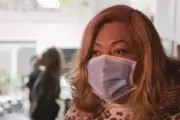This content is sponsored by Johns Hopkins Medicine.
In many parts of the world, cases of COVID-19 are declining, while other areas are seeing spikes. But the pandemic is still evolving. Doctors, public health experts and researchers are trying to answer tough questions: When will this first wave be over, and will there be a second wave of COVID-19 in the fall?
Because so little is known about the SARS-CoV-2, the coronavirus that causes COVID-19, these are not easy questions to answer, but Lisa Maragakis, M.D., M.P.H., a specialist in infectious disease at Johns Hopkins Medicine, sheds light on what we know now.
Is the first wave of coronavirus over?
No, we’re still in the first wave. In some sense, the spread of the coronavirus so far has been more like a patchwork quilt than a wave. The COVID-19 pandemic in the U.S. is affecting different areas throughout the country in different ways at different times.
Some cities and towns experienced severe outbreaks and appear to be recovering, other places have not had many cases, and some states are only now experiencing a rise in COVID-19. It’s also clear that places where people live or work closely together (nursing homes, multigenerational households, prisons and businesses such as meat packing plants) have tended to see more spread of the coronavirus.
Although some areas are reporting declining numbers of infections and deaths, localized outbreaks at nursing homes and “superspreader” events — in which one infected person transmits the virus to many others at a gathering — continue to occur.
Why are there coronavirus spikes?
As communities begin to reopen, people are understandably eager to be able to go out and resume some of their regular activities. But we don’t yet have an effective therapy or vaccine, so the reopenings are intended to take place safely while maintaining social distancing, and masking and hand-washing as we’ve done over the last few months. Some people relax these infection prevention efforts as soon as places begin to reopen, and this can cause the number of coronavirus infections to rise.
There seems to be a long delay between a policy change in a community and when its effects show up in the COVID-19 data. As locations reopen businesses, they might not see any effects, such as an increase in the number of COVID-19 cases or hospitalizations, a week or even two weeks later. It seems to take much longer, perhaps as many as eight weeks, for effects to appear in the population-level data.
When a person is exposed to the coronavirus, it can take up to two weeks before they become sick enough to go to the doctor, get tested and have their case counted in the data. It takes even more time for additional people to become ill after being exposed to that person, and so on. Several cycles of infection are likely to occur before a noticeable increase shows in the data that public health officials use to track the pandemic.
So when an area relaxes social distancing guidelines and “reopens,” the effects of that change might take a month or more to be seen. Of course, surges after reopening also depend on the behaviors of people when they start moving around more. If everyone continues to wear masks, wash their hands and practice social distancing, reopening will have a much lower impact on transmission of the virus than in communities where people do not continue these safety precautions on a widespread basis.
Is warm weather helping to lessen COVID-19’s impact?
In the beginning of the pandemic, some experts wondered if warmer weather would slow down the spread of the coronavirus. Some respiratory illnesses, like colds and influenza (flu), are more common in the colder months, so researchers are trying to find out if this is true of COVID-19.
In one study, warm weather reduced coronavirus spread by 20%. Even if that trend is accurate across the country, the pandemic might slow down but it would be unlikely to end. So far, we have not seen evidence that SARS-CoV-2 transmission is slowed by warm weather.
Why are experts concerned about a second wave of coronavirus?
A second surge could happen before fall, with human behavior playing a major part. People are frustrated. Cellphone data are showing decreased social distancing. It takes weeks for the number of COVID-19 cases to change after a major behavior shift, so in June, we’re seeing a reflection now of what was going on in early April. Since then, we’ve had better weather, Passover, Easter, Mother’s Day and Memorial Day. By the end of this summer, we’re going to see the results of behavior changes that took place over those events and that period of time.
When predicting the future of the COVID-19 pandemic, experts look to other pandemics and the behavior of other viruses. Examples include the 1918 flu pandemic and the 2009 H1N1 flu epidemic. Both of these events began with a mild wave of infections in the spring, followed by another surge of cases in the fall.
Around the world, according to the World Health Organization, a resurgence of COVID-19 is a threat. Areas that were hit hard by the coronavirus in the winter, such as China, Italy and Iran, are still on guard for outbreaks. Some countries have already relaxed closures and distancing measures, even though new infections are still occurring. Even countries with strict lock-down policies over the winter, such as China, are seeing new cases.
Will a second wave of coronavirus be worse in the fall?
It could be, because people infected with the coronavirus are capable of transmitting it to others even before they develop any symptoms themselves, and we are worried about what will happen when the virus circulates along with other respiratory viruses like influenza.
When the coronavirus first appeared in the U.S. in early 2020, it started with a very small number of infected people, so it took longer to spread. A second wave could start with many unknowing coronavirus carriers in many different areas, and the risk of transmission increases when people spend more time together indoors, which is more common in the fall and winter months.
It’s a challenge because now there are so many different chains of infection to follow. At the beginning, we had the opportunity to do contact tracing and quarantine, but now that the disease is widespread, it makes it harder to detect and control transmission.
Can I get coronavirus twice?
Researchers are eager to answer this question. Right now, it’s not known. If SARS-CoV-2 behaves like other coronaviruses, such as those that cause mild colds, some experts say you might be immune for a while and then lose that immunity within a few months. Studies are ongoing, but we don’t yet know whether an antibody response to SARS-CoV-2 protects someone from getting the infection again at a later time.
COVID-19 in the Fall: Other diseases could complicate the picture
An increase in COVID-19 cases in the fall could be troublesome, because seasonal flu is likely to be accelerating at the same time. If the coronavirus surges in the fall and the flu season is bad, the combination could put hospitals and patients at risk. In the U.S. during the 2019–2020 flu season, the Centers for Disease Control and Prevention reported 39 million cases and 24,000 deaths.
Another concern is that since the COVID-19 pandemic began, far fewer children have been getting their regular vaccinations. An outbreak of pertussis (whooping cough), measles, flu or other preventable disease in children could also complicate the picture, making it harder for doctors and hospitals to care for all patients.
When will we have herd immunity from coronavirus?
Herd immunity is a public health term. When enough people in a community have immunity from a disease, it protects the community from outbreaks of that disease.
Infectious disease experts at The Johns Hopkins University explain that about 70% of the population needs to be immune to this coronavirus before herd immunity can work. People might be immune from the coronavirus if they have already had it, but we don’t know this yet. A widely available, safe and effective vaccine may not be available for many months.
Preparing for a Second Wave of Coronavirus
Doctors, clinics and hospitals recognize the chance that COVID-19 cases could start increasing in the fall. They are working with manufacturers to stock up on equipment, and they are continuing their policies for protecting patients and staff members.
Here’s what you can do now:
- Continue to practice COVID-19 precautions, such as physical distancing, hand-washing and mask-wearing.
- Stay in touch with local health authorities, who can provide information if COVID-19 cases begin to increase in your city or town.
- Make sure your household maintains two weeks’ worth of food, prescription medicines and supplies.
- Work with your doctor to ensure that everyone in your household, especially children, is up to date on vaccines, including this year’s flu shot when it is available.




